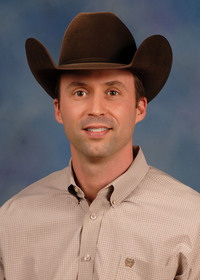Beef Showmanship
Showmanship is an area over which you have the most control when exhibiting your beef cattle. In showmanship, you are judged on your ability to control and present an animal to bring out its best characteristics. Advanced planning and hard work are important keys to becoming a good exhibitor.
Showing beef cattle generates enthusiasm and competition in the showring and teaches valuable life skills, which include learning responsibility, making decisions, learning to win graciously, and instilling character. A good showman has a sense for effectively presenting an animal in competition.
Start Early
Success in beef cattle showmanship must start at home with halter breaking the calf. Properly put a rope halter on the calf, and let the lead rope drag on the ground for 2 to 3 days. This makes the calf aware of the halter.
Next, tie the calf for an hour, working up to 3 to 5 hours a day. During this time, brush and talk to your calf. This will assist in calming the calf and allow it to become accustomed to you. In time, the calf will respond to your hand movements with the halter and show stick.
Training a calf to walk, stop, and set up easily takes work and patience. At first, lead the calf to and from feed and water. Later, lead the calf around for short practice sessions to teach it to set up in response to the halter and show stick. Have another person handle the calf while you are at the halter; this trains the calf to remain calm under a judge’s close inspection.
Using the Halter
Place the halter on the calf’s head with the lead on the left side. Put the cross strap that goes over the nose 2 to 3 inches below the eye. You can adjust rope halters and show halters for proper fit. Do not have the halter so big that the nose-cross piece is down by the mouth.
You must use a permanent nose lead to show bulls. This provides better control and increased safety for all exhibitors. Handle the nose lead as one with the halter lead strap; provide equal pressure to both leads.
When leading, walk on the calf’s left side with the lead in your right hand. Hold your hand 6 to 12 inches from the animal’s head on the lead strap. (This is near the junction of the chain and leather strap.) Firmly grip the lead so your thumb is up and toward you with your little finger nearest the chain. Your wrist is stronger this way and provides better control over the animal.
Measure the lead strap to be just long enough for control (about shoulder width). It must not touch the ground; if the lead can reach the ground, you or the calf may step on it, making it awkward to switch hands. To prevent injury, do not wrap the halter strap around your hand or fingers.
Using the Show Stick
Four basic uses for the show stick include:
- Assisting in placing the feet.
- Calming and controlling the animal.
- Keeping the top level.
- Scotch-driving the animal.
When setting up your calf:
- Switch the lead strap from your right hand to your left hand quickly and smoothly.
- Switch the show stick from your left hand to your right hand.
- Slowly scratch the calf’s belly a couple of times to help calm the calf.
- Set the calf’s feet in the appropriate position.
Remember: You have two tools in your hands to set the feet—the lead and the show stick. Set the rear feet first. To move a rear foot back, push backward on the lead and use the show stick to press (not jab) the soft tissue between the toes in the cleft of the hoof. To move a rear foot forward, pull on the lead and use the show stick to apply pressure under the dew claw (Figure 1).
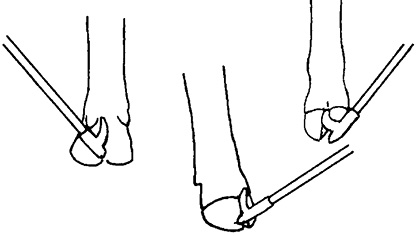
It is easier for the calf to put a foot back than forward. When the rear feet are too close together, apply pressure to the inside of the leg just above the hoof or at the hock, and the calf should stand wider. You can move its front feet by using your boot or show stick to apply pressure on the foot while pushing or pulling with the halter lead in the direction you want the foot to move. Younger, less experienced exhibitors are safer using the show stick.
Placement of the feet depends on what view is desired for the judge and what makes the calf look its best. When cattle are lined up side by side in a straight line, the feet should be set on all four corners (bearing a full share of the calf’s weight). On this view, the judge is looking at the rear and front of the calf.
When the cattle are lined on the profile (head to tail), set the feet as if a professional photographer is taking a picture. Stagger the rear feet so your near side foot is slightly in front of the foot closest to the judge (Figure 2). As the judge moves to the rear of the calf on profile, an experienced exhibitor will again square the feet. As the judge moves back to the side view, profile the rear feet again.
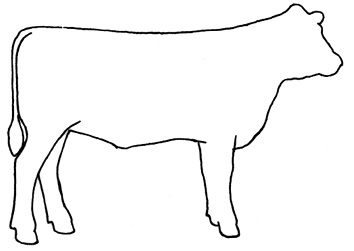
A heel-to-toe relationship works best when profiling. The heel of one foot is parallel with the toe of the other foot. The front feet are set squared or staggered less than the rear feet. The toe of the front foot away from the judge should be set back half the width of the hoof on the judge’s side. By setting the feet in this manner, you give the judge a perception of depth and thickness. It also makes it easier to correct a top line and rump structure.
When using the show stick to correct a top line:
- Apply pressure at the navel or flank with the hook of the show stick if the top is weak and needs to be raised.
- If the rump is steep and the loin is high, apply pressure to this area to bring it down; continue to scratch the calf’s belly to keep it calm.
While showing, always keep the point of the show stick down for safety and professional appearance. Keep the stick in your left hand at the handle or about one-third of the way down when walking. This allows its use as an additional control tool if needed. If the calf is moving too fast, hold the portion of the stick between your left hand and tip or hook end in front of the calf’s nose.
To scotch-drive, push forward on the halter with your right hand, and touch the calf with the show stick on its side or rump. This makes the calf think someone is behind it, and it should start to walk. Scotch-driving is needed when the calf will not lead or walk and no one is around to help you get started.
Using the Comb or Cloth
With haired cattle, carry a scotch comb in your right back pocket or in a comb sheath, with the teeth toward you for safety. Use the scotch comb to groom the hair that becomes messed up from the judge’s handling or from another animal bumping into your calf. You can use the corner of the comb to level the loin.
If showing American breeds with short hair, carry a wipe cloth (bandana). You can use the cloth in the same manner as the scotch comb to groom the hair while in the showring.
At Show Time
Before the show, walk over the showring to find any low spots on the surface. This will help you avoid these areas when setting up your calf. If possible, position the calf so the front feet are placed on higher ground than the rear feet.
Dress neatly and look like a livestock exhibitor. Wear leather boots for safety and to look your best. If the calf steps on your foot, its foot will slip off a leather boot more easily than off a canvas shoe.
Wear nice jeans or slacks; avoid faded or torn blue jeans because they do not look professional. Wear a button-down or Western shirt; do not wear a T-shirt. Leave hats or caps at the grooming area because they distract the judge’s attention from your calf.
Enter the showring promptly when the class is called. Have the proper equipment and exhibitor number for the calf you are showing. Unless instructed differently or wearing a number harness, always wear your exhibitor number on the left side so it does not interfere with use of the show stick or leading the calf.
Know where to line up and how the classes will move through the showring. If you are not in the first class, watch a class or two to learn specific techniques or show styles the judge prefers. The advanced exhibitor is able to adapt to any situation and provide the judge with exactly what he or she is looking for on that particular day. If the judge prefers you show differently, adapt. However, in most situations, if you follow the showmanship techniques outlined here, you will be successful.
Generally, cattle are lined up side by side to start a class. When pulling into line, look where you will be, and head into that position. Do not merely follow the person in front of you since this usually ends in an “S” configuration. You can end up brushing against the calf that was in front of you as you pull into line.
When pulling into line, check your calf a few feet before reaching your destination to slow the calf. To check the calf, lift up slightly on the halter so the calf knows you are about to stop.
When walking into the ring, line up where the ring steward indicates. If you are third or fourth in the ring, line up even with the other calves, leaving 3 or 4 feet on both sides of your calf. This allows ample room for all exhibitors to set up. Smoothly, yet quickly, get the calf set up with its head high.
Be alert, keep a close eye on the calf, keep the feet set square, stay straight in line, and know where the judge is located. If your calf is not set square and the judge is nearby, set up your calf. Most judges will wait for you to present the calf at its best. Always give the judge the view he or she is seeking. Very little movement around the front end is required for you to present the calf properly.
When it is time to walk the cattle:
- Move as the judge or ring steward instructs. Most likely, you will pull the cattle up to the rail, turn left, go three-fourths of a circle, and walk right behind the tail of the other cattle in the side-by-side line.
- Assist the exhibitor in front of you in moving a calf if he or she is having trouble. Tap the calf’s rump with your stick, or, preferably, put your show stick in your right hand and twist the tail of the calf in front of you with your left.
- Let your calf walk out freely. Move at an easy pace, not too slow or too fast.
When it is time to stop on the profile:
- Stop in a straight line head to tail. Remember to check the calf and then stop by lifting its head. Allow 4 to 6 feet between your calf and the one in front. This allows the judge space to move freely around the cattle and helps to prevent calves from mounting or disturbing others in the line.
- Position the feet as discussed earlier; keep the top line level and the calf’s head up.
- Locate the judge and wait calmly. Do not “saw” your calf in half with rapid stick movement while waiting for the judge. Use slow, deliberate strokes with the show stick. Do not make noises or rattle the chain of the halter.
The judge may handle the cattle and ask a few questions. As the judge moves around the calf, move a half step back to allow the judge a full view. Be prepared to answer questions such as weight, birth date, sire, dam, pregnancy status of your heifer, feeding program, various parts of the animal, yield grade, quality grade, and the retail cuts of beef.
If your calf has not moved and the judge has gone to the next animal, use the scotch comb or wipe cloth to fix any hair that is messed up. If your calf has moved out of line, pull out in a clockwise circle and bring the calf back into line. Set up and then fix the hair if necessary.
Be alert and aware of the judge. Look for a sign or motion to be pulled into line for placing. This may be another profile or side by side line. As the judge pulls cattle from the profile line, empty spaces occur. As spaces between cattle become empty, move forward in the line.
Remember to allow proper distance between calves, and set the calf up at its best. By moving forward and filling the empty spaces, it becomes easier for the judge to make comparisons. Once pulled into a side by side line, you are nearing the end of the class. Stay alert and set the calf up as positions may continue to be switched.
When turning an animal, always turn to the right (clockwise) unless the ring steward gives other instructions. Pushing the calf’s head away from you prevents the possibility of the calf stepping on your foot, causing harm to you or the calf.
Certain situations may occur in changing placings (Figure 3). Note that you pass back through the same hole you left, then to the proper position. If positioned up to a rail, do not turn around in the line. Back the calf out by pushing back on the halter with your left hand and applying pressure with your right at the point of the shoulder. Pull into the line at the instructed position.
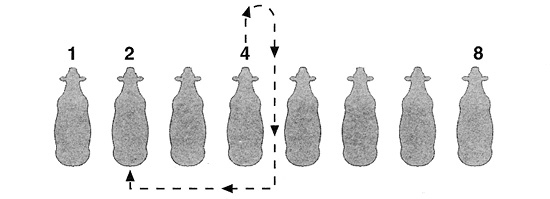
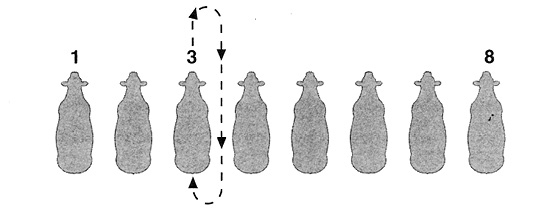
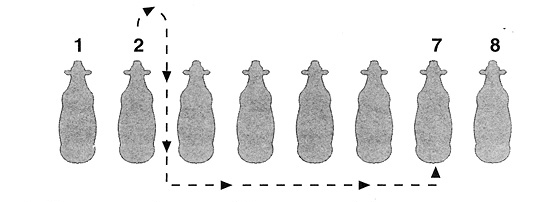
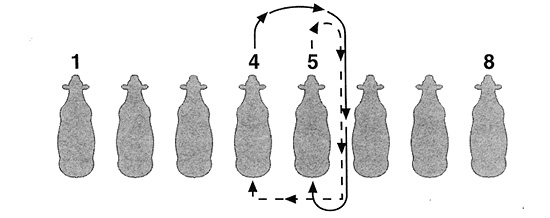
When the judge starts his or her reasons, the class is over, but your job is not. Continue to work hard and display good sportsmanship. Leave the ring in an orderly manner as instructed by the ring steward, and pick up your awards.
Courtesy and Sportsmanship
Keep straight lines so the judge can compare all the animals. Straight lines and 90-degree angles are best in the show ring. If you are blocking the view of another animal and have space, move so the judge can see all the animals; however, if you are the one hidden, it is your responsibility to be where the calf can be seen. Do not rely on other exhibitors since they may not have room to move. Pull back in line on the end if this is where space is available.
Avoid bumping, crowding, or hitting other animals. If your calf becomes nervous or unruly, act as a professional. Remain calm, be patient, and never get discouraged or lose your temper.
Congratulate the class winners and those who stood ahead of you, or be a gracious winner and encourage those who stood below. Remember: Showing is a learning experience. Leave the ring knowing you have given your best effort. Learn from your mistakes, watch other exhibitors, and improve your skills for the next show. You are always a winner just by having participated in a worthwhile learning activity.
Publication 2210 (POD-04-25)
Reviewed by Dean Jousan, PhD, Extension Professor, Animal and Dairy Sciences. Written by R. Kipp Brown, former Extension Associate.
The Mississippi State University Extension Service is working to ensure all web content is accessible to all users. If you need assistance accessing any of our content, please email the webteam or call 662-325-2262.



